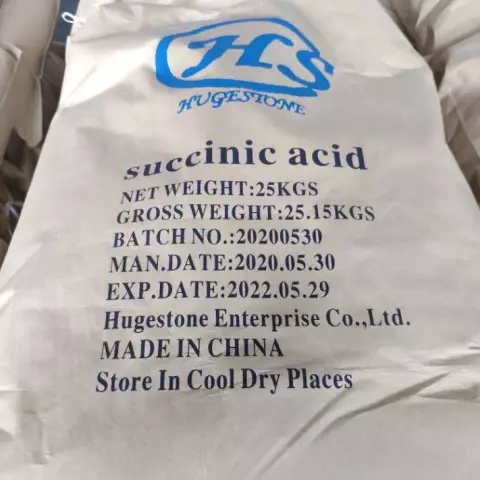- Author Rachel Wainwright [email protected].
- Public 2023-12-15 07:39.
- Last modified 2025-11-02 20:14.
Cytoflavin: analogues of the drug and the benefits of succinic acid
Cytoflavin is a drug that improves metabolic processes in the brain tissue. The balanced composition of the drug acts on the enzyme systems of cells, eliminating hypoxia and restoring the energy potential of neurons.

Composition of Cytoflavin
The composition of the preparation includes:
- Succinic acid.
- Riboflavin (vitamin B2).
- Nicotinamide (vitamin PP).
- Inosine.
Let's dwell on the first component of the drug and consider in detail the benefits of succinic acid.
The enzymatic systems of the body are able to independently synthesize this chemical compound in small quantities, however, with acute circulatory disorders or chronic ischemia of the nervous tissue, its deficiency occurs. This leads to a decrease in the energy reserves of the cells.
Prolonged stay in this state ends with the death of neurons. The use of succinic acid is that it is an additional source of energy. Entering the body, the substance stimulates the vital activity of brain cells, protecting them from starvation.
The use of succinic acid has long been a controversial issue. Some researchers argued that the substance has a positive effect on the body. Others were of the opinion that the harm from the introduction of succinic acid outweighs the benefit.

To date, it has been proven that the use of this chemical compound (according to the instructions for use) is safe, and the effectiveness of protecting the cells of the nervous system from energy hunger is high.
The accumulated data on the benefits of succinic acid allowed drug manufacturers to include it in the composition of various medicines.
Action of Cytoflavin
Due to the unique composition, the complex and expected action of Cytoflavin is provided. Indications for its use are lesions of the central nervous system of various origins:
- Cytoflavin has been shown to be highly effective in patients with neurasthenia. They are usually irritable, complain of quick fatigue, and are unable to perform their usual mental or physical tasks.
- The drug is successfully used for acute or chronic circulatory disorders of the brain. These conditions can be a consequence of stroke, poisoning, the introduction of anesthesia, pathology of the vessels of the head in atherosclerosis and arterial hypertension.
- The action of Cytoflavin is not limited to the restoration of metabolism. The drug has a positive effect on blood flow, improves blood supply to the brain, eliminates sensitivity disorders, normalizes consciousness, and quickly awakens after anesthesia.
Cytoflavin is widely used in neonatological practice, it helps premature babies to overcome cerebral ischemia and improves the further prognosis for their development.
The advantages of the drug include the presence of two forms of release, which allows the use of injections in the acute phase of pathology with a further transition to oral administration. The latter increases the effectiveness of therapy.
For chronic ischemic brain damage, doctors recommend the tablet form of the drug.
Cytoflavin's analogs
The use of Cytoflavin has some limitations. The drug is contraindicated in case of individual intolerance to the components. In this case, specialists have to choose analogues of Cytoflavin.
It should be noted that the pharmaceutical industry is actively working to develop new drugs for the treatment of neurological patients. Despite this, Cytoflavin remains a unique drug in terms of composition and action, which has no direct analogues.
Cytoflavin or Mexidol
One of the indirect analogues of Cytoflavin is Mexidol. The drug is produced by a domestic pharmaceutical company and is sometimes included in the lists of recommendations of neurologists.

The action of Cytoflavin and Mexidol is somewhat similar. Both drugs have an antioxidant effect by fighting free radicals. These substances damage cell membranes, which results in cell death. Also, drugs have the effect of improving blood circulation in the nervous tissue.
A distinctive characteristic of Cytoflavin is an increase in the energy potential of the cell due to the metabolites contained in the composition. In this case, ready-made high-energy compounds that support and improve the vital functions of the nervous tissue enter the neurons. The use of Mexidol only adapts the cells of the brain to conditions of hypoxia and insufficient trophism.
When choosing between Cytoflavin and its analogue Mexidol, you should pay attention to the limitations in the use of the latter. The drug is contraindicated in patients with inhibition of the urinary system and liver. Also, the drug is not used in childhood.
What to appoint - Cytoflavin or Mexidol - must be determined by a specialist. It is worth considering drug interactions. Cytoflavin reduces the activity of some antibiotics, and Mexidol enhances the effect of antiparkinsonian and anticonvulsant drugs.
Cytoflavin or Cerebrolysin
Another indirect analogue of Cytoflavin is Cerebrolysin. The substrate for the production of the drug is pork brain. The resulting active substance - peptide fraction - improves the function of nerve cells and protects them in case of blood supply disturbance.

When choosing between Cytoflavin and Cerebrolysin, it is necessary to pay attention to the form of drug release. As mentioned above, Cytoflavin has 2 forms, and Cerebrolysin has one, which limits its use in patients with chronic diseases.
The question of the pharmacokinetics of Cerebrolysin in contrast to Cytoflavin is not fully understood. It is still unclear how the peptide fraction is distributed in the body. The instructions indicate that there is only indirect evidence that Cerebrolysin crosses the blood-brain barrier. This means that it is impossible to determine exactly how much of the active substance enters the cells of the brain. Hence, a logical conclusion can be drawn: the therapeutic effect of the drug cannot be predicted. Given the data from the instructions, it is quite simple to make a choice between Cytoflavin and Cerebrolysin in favor of the former.
Summing up, I would like to draw your attention to the fact that Cytoflavin is a complex action drug with proven efficacy. It is used to treat acute and chronic brain damage. At the same time, the drug has a minimum number of contraindications - this is also a weighty argument in its favor.
The drug is available in 2 forms, which allows for a full course of therapy, combining the pathways of the active substance entering the body.
And most importantly, there are no direct analogues of Cytoflavin today, therefore, replacing it with other drugs, you may not get the desired treatment result.
Found a mistake in the text? Select it and press Ctrl + Enter.






